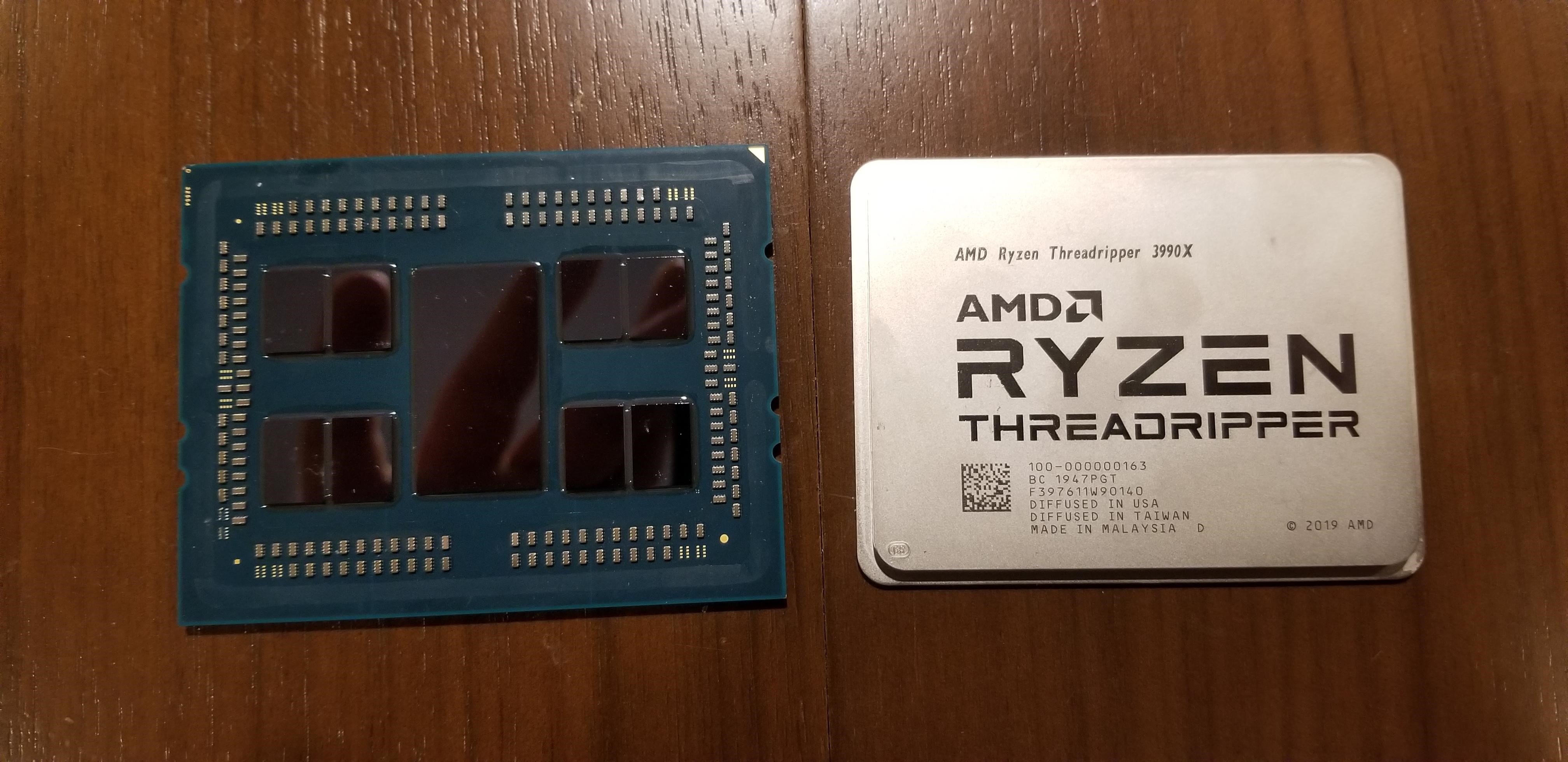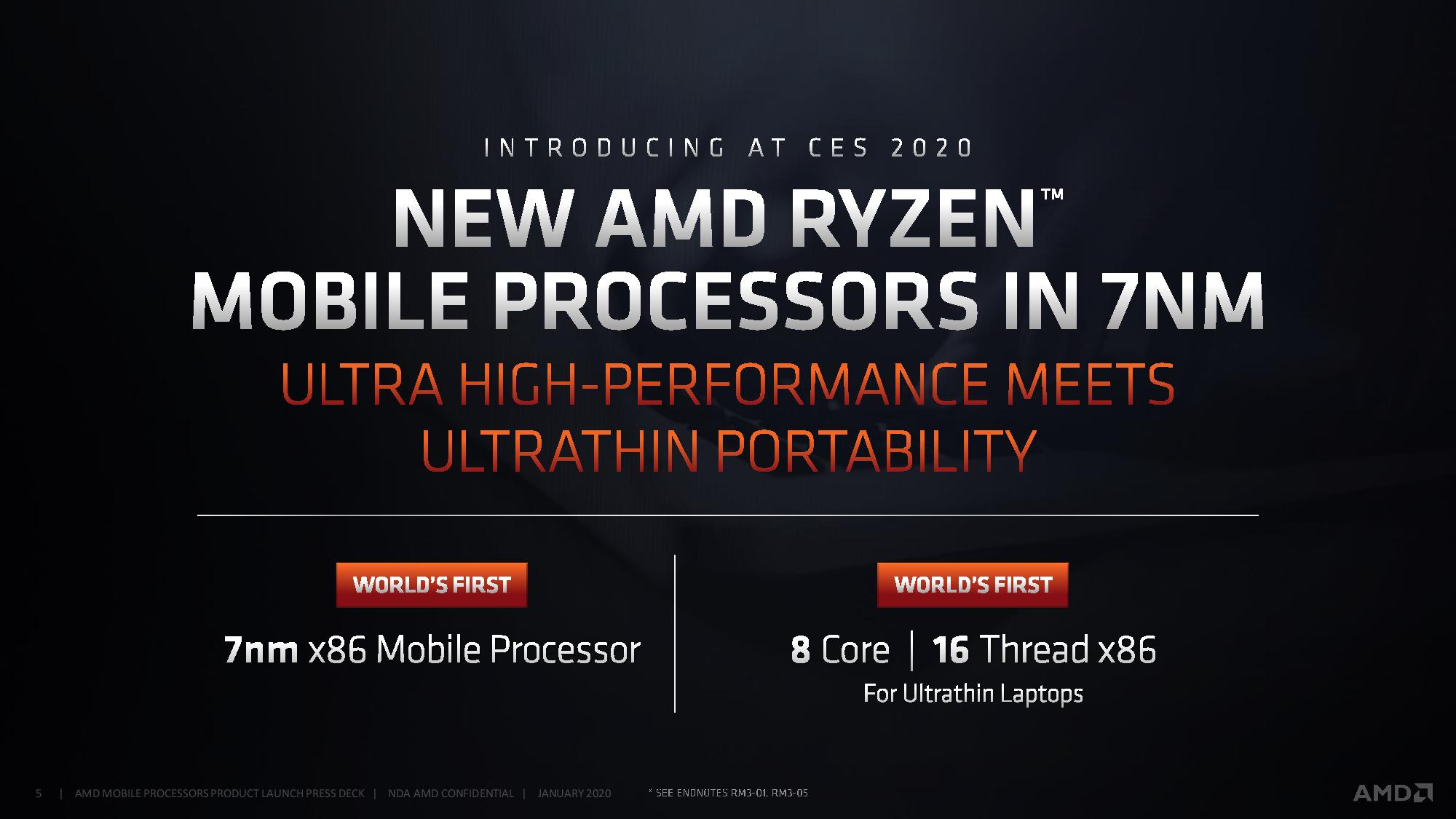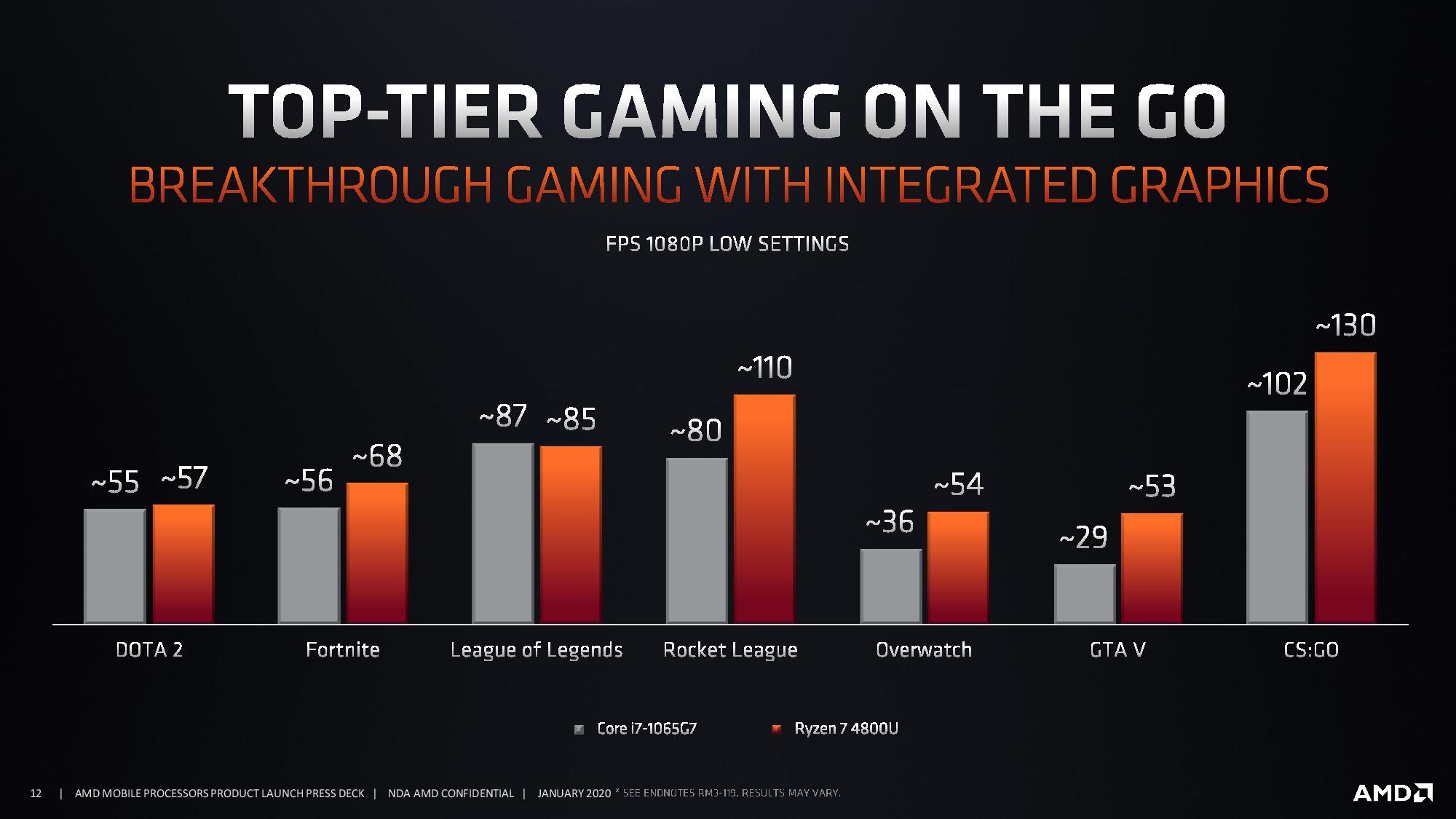AMD Launches Threadripper 3990X and Ryzen 4000 'Renoir' APUs
AMD fires its 7nm salvo at the laptop market and HEDT all at once.
Update 2/7/2020: Check out our AMD Ryzen Threadripper 3990X review to see how the chip stacks up against the competition.
AMD capped it’s whirlwind 2019 with promises of more to come: In particular, the beastly 64-core 128-thread Threadripper 3990X that we now know will come with a suggested pricing of $3,990 and land on February 7, 2020. AMD also finally fleshed out its Ryzen Mobile 4000-series, otherwise known as “Renoir,” that mark the first x86 7nm processors to arrive for the mobile space. These new chips come with up to eight Zen 2 cores and 16 threads paired with a new revamped 7nm Vega graphics engine, marking a new level of competition for Intel in the laptop market. The first laptops come to market in Q1 2020, with over 100+ systems coming throughout the year.
AMD also announced its long-awaited Radeon RX 5600XT, which comes bearing the RDNA architecture, 7nm process, and PCIe 4.0 interface.
Threadripper 3990X


AMD’s launch of the Threadripper 3970X and 3960X marked the beginning of a new era of AMD dominance in the high end desktop market. In fact, these 24- and 32-core models have so much horsepower that Intel doesn’t even have a response, leaving AMD to dominate the high-end market.

But the Threadripper 3990X extends that lead even further. This new processor comes with the same 280W TDP as its counterparts, but sports an unheard-of 64-cores and 128 threads. These cores operate at a 2.9 GHz base but boost up to 4.3 GHz, which is only 100 MHz lower than the targeted peak speeds of the 32-core 64-thread Threadripper 3970X. They also come with an unprecedented 288MB of L3 cache.
These new chips drop into existing sTRX40 motherboards, so there are no special platform requirements. Existing Threadripper cooling solutions and recommendations also still apply, so the 280W TDP shouldn’t be too difficult to tame.
AMD shared some performance projections, highlighting that its Ryzen 3000 series lineup scales well with the addition of more cores, giving the company the uncontested lead on the desktop. The 3990X’s hefty price tag will certainly relegate the chip to the creator and professional markets where the price of the processor is a small consideration considering the monetary gain of getting more work done, faster. Intel has no competing chips even in the range of the 3990X, so AMD is free to rake in a premium for these powerful chips.
AMD Ryzen 4000 “Renoir” APU Family





AMD splits the Ryzen 4000 family up into U-series for ultrathins, H-series for gamers and creators, and Pro-series models for the professional market. AMD’s new Ryzen 4000 series follows the company’s standard naming convention for its APUs, so while these are branded as 4000-series processors, they still come with the same Zen 2 microarchitecture and the 7nm TSMC process as the desktop 3000 series. This makes them the first 7nm x86 mobile processors. The architectural advances and 7nm process should provide AMD a solid step forward on the power efficiency front that has been a sore point for the company’s previous-gen products, and the company also unveiled its new 7nm Vega engine and SmartShift technology.
Get Tom's Hardware's best news and in-depth reviews, straight to your inbox.
U Series





The 15W U-series lineup spans from four-core four-thread models up to eight-core 16-thread models. Yes, in a departure from its normal operating procedures, AMD has disabled SMT (threading) on some SKUs, which the company says is to accommodate custom OEM models. The U-series comes with a configurable TDP that spans from 12W to 25W
AMD says the 7nm process will bring higher core counts into the 15W power envelope, which marks the first time eight cores and 16-threads has squeezed down into thin-and-light devices. The new chips also come with a redesigned 7nm Navi graphics engine that it claims boosts performance within a much more efficient power envelope. AMD says this new engine allowed it to reduce the number of Compute Units (CU) from 11 to 8, while still maintaining what is claims is leading graphics performance compared to Intel’s Ice Lake processors. Due to the optimized 7nm Vega architecture, AMD says it can wring out 59% more performance per CU.
The Ryzen 7 4800U serves as the flagship of the U-series lineup with eight cores, sixteen threads, a 1.8 GHz base, and a 4.2 GHz boost clock speed, all within the 15W power envelope. The Vega graphics engine runs at 1750MHz.
AMD presented a range of tests comparing the Ryzen 7 4800U to Intel’s Ice Lake Core i7-1065G7, highlighting leading performance in all three key metrics: single-threaded, multi-threaded, and graphics performance. However, its noteworthy the company used the CPU-intensive 3DMark TimeSpy physics test for the projection. The company also presented a range of testing in real-world 1080P gaming and creator workloads.
Power Benefits





AMD claims the benefits of the 7nm process combine with optimizations to the SoC power delivery to yield 20% lower power consumption and twice the performance per watt. Other improvements, like a 5X reduction in power state entry and exit, along with the obvious advantages of LPDDR4x memory, also provide a significant step forward for battery efficiency. AMD presented this information for the U-series products, but did not share any power information about the H- or Pro-series processors.
AMD also introduced its new SmartShift technology, which allows the platform to monitor the power states of both the GPU and CPU, both of which provide enhanced telemetry via the Infinity Fabric, to modulate power delivery in real time. This allows the platform to deliver extra power to where it’s needed depending upon the workload, which AMD claims boosts both GPU and CPU performance. AMD says this new tech only works when its CPUs are paired with an AMD discrete GPU, so it won’t work with Nvidia-based systems. The company also announced a new “A+A+A” initiative that it says designates systems with AMD CPUs, GPUs, and drivers. This is partially to encourage OEMs to allow their customers to use AMD’s full driver suite.
H-series







AMD also has an H-series lineup that comes with a 35W nominal TDP rating, but has a configurable TDP range that extends from 35W to 45W, with a 45W nominal and 54W peak power consumption.
The Ryzen 7 4800H comes with eight cores and 16-threads that operate at a 2.9 GHz base and a 4.2 GHz boost. This chip comes with 7 CUs that run at 1600 MHz. AMD also has the six-core 12-thread Ryzen 5 4600H, which has a 3.0 GHz base and 4.0 GHz boost. This processor steps back to 6CU that operate at a 1500MHz.
This family only consists of two models, but AMD claims the flagship can take on even the desktop Core i7-9700K in both creator and gaming workloads. (AMD also used 3D Mark physics test for that gaming performance comparison). AMD also shared its internal test data of several other workloads against the Core i7-9750H.
Athlon






AMD also announced the new Athlon Gold and Silver models that flesh out its lineup of Chromebook-optimized chips.

Paul Alcorn is the Editor-in-Chief for Tom's Hardware US. He also writes news and reviews on CPUs, storage, and enterprise hardware.
-
The_Arioch Tom on APU: The new chips also come with a redesigned 7nm Navi graphics engineReply
Navi???
Or Vega? -
The_Arioch Tom: AMD also has an H-series lineup that comes with a 35W nominalReply
Picture: 45W Nominal -
HideOut IMO AMD needs to make a 4650U. Same 6/12 config but with the higher powered graphics of the 4800. Make it the ulimate mid range gaming chip.Reply -
JayNor Looks like Tiger Lake will be the Renoir competitor in the holiday season... Intel claims 2x graphics performance of the Tiger Lake integrated Xe vs the previous gen (Ice Lake gen11?)Reply -
cryoburner Reply
The graphics are not exactly going to be "gaming grade" on any of these chips. 59% more performance per compute unit sounds great, but they cut the maximum number of compute units down from 11 to 8, countering much of those gains. So compared to their last generation of mobile APUs, it sounds like the graphics performance may only be improving by around 15-20% at the top-end. So, we're still talking about graphics hardware around the performance of a desktop GT 1030. Maybe you'll be able to manage playable performance in the latest demanding games at 720p with low settings, and will probably be able to push 1080p60 in some esports and older titles, but I wouldn't expect much more than that from them. These will mainly be best suited for those who want a 6 or 8-core processor and don't care about gaming, or for gaming laptops where they will be paired with dedicated graphics, allowing them to switch to the integrated when not gaming to save on power.HideOut said:IMO AMD needs to make a 4650U. Same 6/12 config but with the higher powered graphics of the 4800. Make it the ulimate mid range gaming chip. -
hannibal ReplyThe_Arioch said:Tom on APU: The new chips also come with a redesigned 7nm Navi graphics engine
Navi???
Or Vega?
Vega. -
dalauder Reply
If you want ultimate midrange gaming, go for fully optimizing it: 4 cores/8 threads is the sweet spot on price/performance RIGHT NOW. If you're going for a $400 "gaming" laptop, you're not future-proofing.HideOut said:IMO AMD needs to make a 4650U. Same 6/12 config but with the higher powered graphics of the 4800. Make it the ulimate mid range gaming chip.
Do an R3 4400U that's 4/8 with 8+ CUs. I wonder if they could squeeze 12 or 16 CUs on a processor since 4 cores would only use up one chiplet? It might be a KILLER budget gamer. Just insist that manufacturers can only pair it with 3200MHz memory or faster. -
bigdragon I think it's time for AMD to launch it's own Ultrabook-like campaign. These upcoming chips are impressive. However, AMD is not going to make the market gains against Intel that it needs in the mobile space while OEMs keep slapping AMD hardware into spec-limited, budget machines.Reply -
mcintda Re: laptop market shareReply
The problem is that companies don't want to buy machines their employees can play games on. Which gives you two separate market segments : budget user / gamer (two as one) , and business users.
The former isn't profitable. As for the latter, business users care about price and power usage / duration. They might like to game, but only Mgmt. can dictate what machines to buy; the average user takes what they're given. And expressly, they won't be gaming-capable.
AMD seems to be shooting for enthusiast products while ignoring profitable market segments. -
cryoburner Reply
AMD's chiplets for their desktop processors actually have 8 cores each, which is why two of them together allow AMD to go up to 16 cores on the AM4 platform.dalauder said:I wonder if they could squeeze 12 or 16 CUs on a processor since 4 cores would only use up one chiplet?
As far as I know, these laptop APUs won't be using chiplets though, but rather a monolithic design with the graphics, processor cores and IO all on the same chip. We might potentially see something different for their desktop APUs though, where efficiency and size is a bit less of a concern.